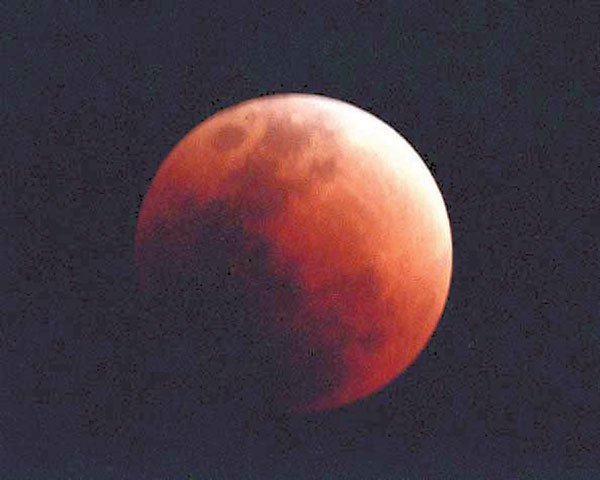By David Baumgartner
Lately it seems to me that every time some spectacular
astronomical event happens it does so somewhere in Europe or in the
Antarctica, and we get left behind wondering what it all looked
like. But on the evening of Oct. 27 at moonrise we have the
distinct pleasure of witnessing a total eclipse of the Moon.
By David Baumgartner
Lately it seems to me that every time some spectacular astronomical event happens it does so somewhere in Europe or in the Antarctica, and we get left behind wondering what it all looked like. But on the evening of Oct. 27 at moonrise we have the distinct pleasure of witnessing a total eclipse of the Moon.
Known as a lunar eclipse, this unique event happens when the Sun, Earth and Moon all line up in a row and the Moon slowly passes through the Earth’s shadow, giving the moon a deep orange-red cast.
Here on the West Coast, we will witness the full Moon rising just after 6pm with the eclipse already under way – a small bite will be taken out of the Moon’s lower edge. The total eclipse will start at approximately 7:23pm, with mid-eclipse at 8:03pm. The show will be over by 8:45pm. The southern half of the Moon will be darker because it passes closest to the center of the Earth’s shadow.
In some ways it may remind us of looking through a large telescope at the planet Mars when it was prominent one year ago, and we saw a bright polar cap with patchy, darker markings on the disk. But for this event, we won’t need a telescope.
Just sit back in your easy chair and enjoy the remarkable view with your unaided eyes.
The next total lunar eclipses won’t happen again until March 3 and Aug. 28 of the year 2007. So you don’t want to miss this one – it is one of the easiest and most beautiful sky events of all to witness.
If you have a 35mm camera, this might be the time to try your hand at some photography of the unusually colored moon. Set your camera to infinity and open the lens all the way, set it to bulb, and take an hour-and-a-half shot. You will catch the whole eclipse from start to finish.
Makes for an unusual but delightful picture.
For some reason, humans feel that they have to give everything around them a name. And when they do, they seem to always exaggerate, whether it is with the size, color or whatever … it never seems to look like what they name it.
Have you ever seen a red-breasted robin? I haven’t. Though I have seen an orange-breasted robin. So how about a blue moon? I have been viewing the moon all my life, and have yet to glance upon one that was blue.
The name “moon” just wasn’t good enough for our Earth’s little partner. We needed to give it more names. How about if we give the Moon a different name for each month? Well, too late, that has already been done.
There are many traditional names for the full Moons of each month of the year. It is doubtful that they have much meaning in our society today, except for the “harvest” and “hunter’s” moons, and the more popular “blue boon,” which we have already figured out isn’t really blue.
So, for your interest only, or for those crossword puzzle enthusiasts, here are the monthly full moon names:
January: Old Moon, or Moon after Yule. Yule is Christmas.
February: Snow Moon, Hunger Moon or Wolf Moon.
March: Sap Moon, Crow Moon or Lenten Moon.
April: Grass Moon, Egg Moon, Easter Moon or Paschal Moon.
May: Planting Moon or Milk Moon.
June: Rose Moon, Flower Moon or Strawberry Moon.
July: Thunder Moon or Hay Moon.
August: Green Corn Moon or Grain Moon.
September: Fruit Moon or Harvest Moon.
October: Hunter’s Moon.
November: Frosty Moon or Beaver Moon (probably because beavers are active in preparation for winter).
December: Moon before Yule or Long Night Moon (an appropriate name because the midwinter night is long and the moon is above the horizon a long time).
Well, there you are. Very interesting for what it’s worth.
It is so amazing how much is up there to see. No matter where in the sky you happen to be looking, there will always be something that will pique your interest.
So if your dusty telescope is still locked away somewhere, now is the time to wipe it off, point it to the sky and see what you can see. Don’t forget family and friends when you do. You don’t have to worry about explaining what they are looking at; the sky is perfectly capable of speaking for itself.
Clear skies.
David Baumgartner is in local real estate and is an avid amateur astronomer. His Sky Watch column appears monthly.
October Sky Watch
Oct. 2: Moon passes 1.6 degrees southeast of the Pleiades. (Also known as the Seven Sisters or the Milk Dipper.)
Oct. 5: Moon is farthest from the Earth. (Apogee: 251,237 miles.)
Oct. 6: Moon at last quarter.
Oct. 7: Moon is 5.4 degrees north of Saturn.
Oct. 10: Moon is 3.5 degrees north of Venus.
Oct. 12: Moon is 1.4 degrees north of Jupiter.
Oct. 13: New moon.
Oct. 17: Moon is closest to the Earth. (Perigee: 228,514 miles.)
Oct. 20: Moon at first quarter.
Oct. 21: Orionid meteor shower peaks.
Oct. 21: Moon passes 5 degrees south of Neptune.
Oct. 23: Moon passes 4 degrees south of Uranus.
Oct. 24: Jupiter’s moons Io, Europa and Callisto form a compact grouping before dawn.
Oct. 27: Full Moon, total lunar eclipse.














